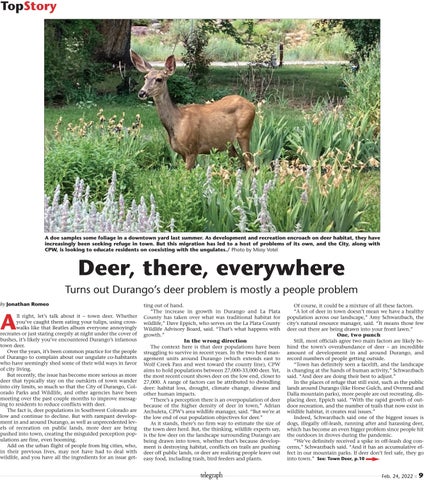TopStory
A doe samples some foliage in a downtown yard last summer. As development and recreation encroach on deer habitat, they have increasingly been seeking refuge in town. But this migration has led to a host of problems of its own, and the City, along with CPW, is looking to educate residents on coexisting with the ungulates./ Photo by Missy Votel
Deer, there, everywhere Turns out Durango’s deer problem is mostly a people problem by Jonathan Romeo
A
ll right, let’s talk about it – town deer. Whether you’ve caught them eating your tulips, using crosswalks like that Beatles album everyone annoyingly recreates or just staring creepily at night under the cover of bushes, it’s likely you’ve encountered Durango’s infamous town deer. Over the years, it’s been common practice for the people of Durango to complain about our ungulate co-habitants who have seemingly shed some of their wild ways in favor of city living. But recently, the issue has become more serious as more deer that typically stay on the outskirts of town wander into city limits, so much so that the City of Durango, Colorado Parks and Wildlife, and other agencies have been meeting over the past couple months to improve messaging to residents to reduce conflicts with deer. The fact is, deer populations in Southwest Colorado are low and continue to decline. But with rampant development in and around Durango, as well as unprecedented levels of recreation on public lands, more deer are being pushed into town, creating the misguided perception populations are fine, even booming. Add on the urban flight of people from big cities, who, in their previous lives, may not have had to deal with wildlife, and you have all the ingredients for an issue get-
ting out of hand. “The increase in growth in Durango and La Plata County has taken over what was traditional habitat for wildlife,” Dave Eppich, who serves on the La Plata County Wildlife Advisory Board, said. “That’s what happens with growth.” In the wrong direction The context here is that deer populations have been struggling to survive in recent years. In the two herd management units around Durango (which extends east to Wolf Creek Pass and west toward the county line), CPW aims to hold populations between 27,000-33,000 deer. Yet, the most recent count shows deer on the low end, closer to 27,000. A range of factors can be attributed to dwindling deer: habitat loss, drought, climate change, disease and other human impacts. “There’s a perception there is an overpopulation of deer because of the higher density of deer in town,” Adrian Archuleta, CPW’s area wildlife manager, said. “But we’re at the low end of our population objectives for deer.” As it stands, there’s no firm way to estimate the size of the town deer herd. But, the thinking, wildlife experts say, is the few deer on the landscape surrounding Durango are being drawn into town, whether that’s because development is destroying habitat, conflicts on trails are pushing deer off public lands, or deer are realizing people leave out easy food, including trash, bird feeders and plants.
telegraph
Of course, it could be a mixture of all these factors. “A lot of deer in town doesn’t mean we have a healthy population across our landscape,” Amy Schwarzbach, the city’s natural resource manager, said. “It means those few deer out there are being drawn into your front lawn.” One, two punch Still, most officials agree two main factors are likely behind the town’s overabundance of deer – an incredible amount of development in and around Durango, and record numbers of people getting outside. “Town has definitely seen a facelift, and the landscape is changing at the hands of human activity,” Schwarzbach said. “And deer are doing their best to adjust.” In the places of refuge that still exist, such as the public lands around Durango (like Horse Gulch, and Overend and Dalla mountain parks), more people are out recreating, displacing deer, Eppich said. “With the rapid growth of outdoor recreation, and the number of trails that now exist in wildlife habitat, it creates real issues.” Indeed, Schwarzbach said one of the biggest issues is dogs, illegally off-leash, running after and harassing deer, which has become an even bigger problem since people hit the outdoors in droves during the pandemic. “We’ve definitely received a spike in off-leash dog concerns,” Schwarzbach said. “And it has an accumulative effect in our mountain parks. If deer don’t feel safe, they go into town.” See: Town Deer, p.10 Feb. 24, 2022 n
9




